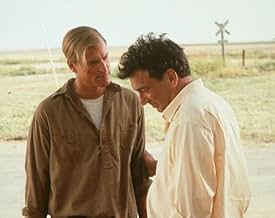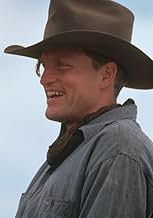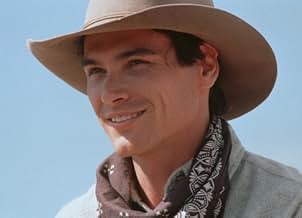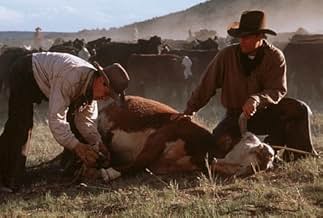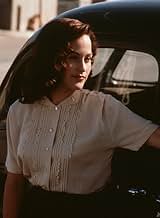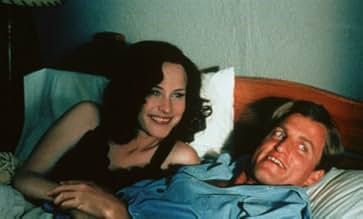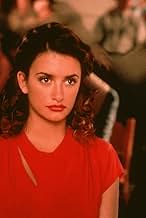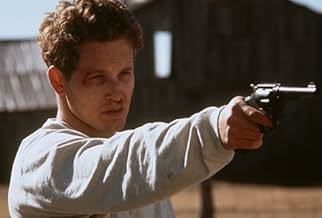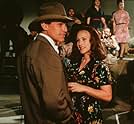The Hi-Lo Country
- 1998
- Tous publics
- 1h 54min
NOTE IMDb
6,1/10
4,7 k
MA NOTE
Deux cow-boys mettent leur amitié à l'épreuve lorsqu'ils tombent amoureux de la même fille.Deux cow-boys mettent leur amitié à l'épreuve lorsqu'ils tombent amoureux de la même fille.Deux cow-boys mettent leur amitié à l'épreuve lorsqu'ils tombent amoureux de la même fille.
- Réalisation
- Scénario
- Casting principal
- Récompenses
- 4 victoires et 4 nominations au total
Darren E. Burrows
- Billy Harte
- (as Darren Burrows)
Avis à la une
The point of this exercise escapes me. Today, in 1999, there are probably two valid reasons for reviving a relic of a genre - to provide an old-fashioned, nostalgic, action-packed adventure, or to remould the Western in our age's image, to try to see what the form can say about us, our ideologies, and, most importantly, our relation to history. This film does neither.
On the one hand, it has many of the virtues of the traditional Western - lovingly bleached landscapes; a pompous, overwrought score; cattle runs; male bonding. But it has neither a compelling narrative drive, charismatic characters, nor a mythic sensibility.
On the deconstructive side, it seems to want to critique the problematic values of the West. The maverick rebel versus corporate muscle is, as has been pointed out, a theme worthy of Peckinpah, but its treatment lacks his romantic passion, violent sympathy, or dynamic self-pity.
The hero, Big Boy, is, according to some, a subject of the film's censure, but the only fault I can find in him is that he is probably impotent, and if that's supposed to be an iconoclastic weakness, than the filmmakers are being rather macho. So he's a bit wild and brutal; he's also loyal, dignified and amusing, and Woody Harrelson invests him with much charm. The rest of the characters, especially Pete, with his wretched narration(there are never voiceovers in Westerns!), are dull and unreal.
Jim Kitses has called the film a melodrama, and to an extent this is true - this is no quest narrative; there is no building a white US culture, no battle between the primitive and civilisation as one finds in the Fordian western. Much of the action focuses on the domestic. A recurring motif is barbed wire, suggesting that the characters are as corralled as the animals they steer, in a prison whose walls actively hurt.
The film is also faintly unusual in having a woman in a pivotal role, although Patricia Arquette is, as usual, quite appaling. However, without me revealing it, the coda betrays all this, reverts twofold to the old 'Print the legend' pack of lies, and still holds out faith in the 'Go west, young man' myth, exactly as they did in the old days.
Stephen Frears has been praised for adapting to the mores of the Western, but this is surely untrue. Photographing desert landscapes, however beautifully, does not make you a great Western filmmaker. You must have a critical apparatus, whether its through the use of montage, like Peckinpah, or though music and composition, like Leone. As a revisionist, Frears has actually regressed from these masters. There is very little of his stamp at all, none of the genre knowledge he showed in The Grifters, one of the great films of the 90s.
He is best at revealing claustrophobic and deceitful sexual tensions and power games between small groups of (often related) people. There are some excellent examples of this here, especially when the four lovers gather after the barroom brawl; there are also a few good scenes, and gorgeous silhouettes: but mostly the thing flounders in its own insecurity and reverence.
On the one hand, it has many of the virtues of the traditional Western - lovingly bleached landscapes; a pompous, overwrought score; cattle runs; male bonding. But it has neither a compelling narrative drive, charismatic characters, nor a mythic sensibility.
On the deconstructive side, it seems to want to critique the problematic values of the West. The maverick rebel versus corporate muscle is, as has been pointed out, a theme worthy of Peckinpah, but its treatment lacks his romantic passion, violent sympathy, or dynamic self-pity.
The hero, Big Boy, is, according to some, a subject of the film's censure, but the only fault I can find in him is that he is probably impotent, and if that's supposed to be an iconoclastic weakness, than the filmmakers are being rather macho. So he's a bit wild and brutal; he's also loyal, dignified and amusing, and Woody Harrelson invests him with much charm. The rest of the characters, especially Pete, with his wretched narration(there are never voiceovers in Westerns!), are dull and unreal.
Jim Kitses has called the film a melodrama, and to an extent this is true - this is no quest narrative; there is no building a white US culture, no battle between the primitive and civilisation as one finds in the Fordian western. Much of the action focuses on the domestic. A recurring motif is barbed wire, suggesting that the characters are as corralled as the animals they steer, in a prison whose walls actively hurt.
The film is also faintly unusual in having a woman in a pivotal role, although Patricia Arquette is, as usual, quite appaling. However, without me revealing it, the coda betrays all this, reverts twofold to the old 'Print the legend' pack of lies, and still holds out faith in the 'Go west, young man' myth, exactly as they did in the old days.
Stephen Frears has been praised for adapting to the mores of the Western, but this is surely untrue. Photographing desert landscapes, however beautifully, does not make you a great Western filmmaker. You must have a critical apparatus, whether its through the use of montage, like Peckinpah, or though music and composition, like Leone. As a revisionist, Frears has actually regressed from these masters. There is very little of his stamp at all, none of the genre knowledge he showed in The Grifters, one of the great films of the 90s.
He is best at revealing claustrophobic and deceitful sexual tensions and power games between small groups of (often related) people. There are some excellent examples of this here, especially when the four lovers gather after the barroom brawl; there are also a few good scenes, and gorgeous silhouettes: but mostly the thing flounders in its own insecurity and reverence.
Great to see a new western and this one was particularly good to look at: capturing the flat, wide western country with all its beauty and natural dangers and contrasting it nicely with the badly-lit, cramped and emotionally charged interior spaces of its bars, farmsteads and honky-tonks. Outside there might be sun, drought, wind and snow, all largely visited at nature's whim; inside there's all sorts of very human dangers, including: infidelity, cheating, financial and legal corruption, and witchcraft - which can all be largely seen as a breaking down of loyalty and trust. War, the demands of the market-place and changing times in general, are shown to have bought a dislocation to the traditional rural certainties of conduct and order; the same forces splitting both the community at large and individual families.
Ed Buscombe's masterly review in Sight and Sound articulated my own slight sense of disappointment with the film. He rightly saw that the character of Big Boy, as played by Woody Harrelson, fails to convince that he is worthy of the strength of love and loyalty that Pete and others feel for him. As Buscombe says, his antics too often subside into a charmless boorishness - contrast this say with Kristofferson's Billy the Kid for Peckinpah, whose behaviour is equally wild but we never doubt his basic goodness and accept the affection in which he is generally held.
The film's recreation of the1940s was very nicely done: with terrific locations and just enough of the right artefacts to suggest the period, rather than an over-dressed museum tableau. The film cleverly slips between that contemporary world and an oppositional timelessness in the unchanging rhythm of the cowboy's life. I liked the way the film's characters acknowledge the anachronistic effort required to follow the cowboy life in 1940s post war USA: "I hear you're having an old fashioned cattle drive" Mona says to Pete, and earlier when Pete suggests to Jim Ed Love, the cattle baron, that "people still drive their cattle to the railhead" he replies "only in the movies".
More than a nod then to Red River, with its fascination with the changing demands of the market place and the effects those changes bring to ranch and cowboy. At heart HiLo is not much more than a rather tacky melodrama but its still very watchable: its lovingly shot, it just about keeps the western mythology alive and it has some great songs. It also has good supporting performances from Billy Crudup (Pete), Patricia Arquette (Mona) and Rosaleen Linehan (Mrs Big Boy), in particular.
Ed Buscombe's masterly review in Sight and Sound articulated my own slight sense of disappointment with the film. He rightly saw that the character of Big Boy, as played by Woody Harrelson, fails to convince that he is worthy of the strength of love and loyalty that Pete and others feel for him. As Buscombe says, his antics too often subside into a charmless boorishness - contrast this say with Kristofferson's Billy the Kid for Peckinpah, whose behaviour is equally wild but we never doubt his basic goodness and accept the affection in which he is generally held.
The film's recreation of the1940s was very nicely done: with terrific locations and just enough of the right artefacts to suggest the period, rather than an over-dressed museum tableau. The film cleverly slips between that contemporary world and an oppositional timelessness in the unchanging rhythm of the cowboy's life. I liked the way the film's characters acknowledge the anachronistic effort required to follow the cowboy life in 1940s post war USA: "I hear you're having an old fashioned cattle drive" Mona says to Pete, and earlier when Pete suggests to Jim Ed Love, the cattle baron, that "people still drive their cattle to the railhead" he replies "only in the movies".
More than a nod then to Red River, with its fascination with the changing demands of the market place and the effects those changes bring to ranch and cowboy. At heart HiLo is not much more than a rather tacky melodrama but its still very watchable: its lovingly shot, it just about keeps the western mythology alive and it has some great songs. It also has good supporting performances from Billy Crudup (Pete), Patricia Arquette (Mona) and Rosaleen Linehan (Mrs Big Boy), in particular.
This movie has all the ingredients to make a great movie. It is beautifully photographed with wonderful western landscapes. It has one of Woody Harrelson's best performances as a hard drinking, hard working, hard loving good old boy rancher. It has excellent support from Sam Elliot, Billy Crudup and Penelope Cruz. It is set in the late 40's, early 50's when small independent ranchers are being replaced by large commercial farms.
The problem with this movie is that is focuses way too much on the three way relationship between Billy Crudup, Woody Harrelson and Patricia Arquette. Arquette and Harrelson are lovers and Crudup lusts after Arquette. This relationship is not believable because Arquette's character is untrustworthy, amoral, and a liar. The woman who is more interested in Crudup is the Penelope Cruz character. The movie never explains why Crudup would prefer Arquette over the much more beautiful and sexy Cruz.
The Sam Elliot character is wasted. He does a good job of portraying the businessman rancher. He is not evil, but all the small time ranchers hate him because he is contributing to, and a symbol of, the end of small ranches. But it is not Sam Elliot that is destroying the small ranches, it is the progress of commercialization which Sam Elliot represents. It is this contradiction between good person Sam Elliot is and the evil that he represents that makes is character so interesting. This movie should have been more about Sam Elliot.
The movie falls apart into silly soap opera / action movie like scenes at the end. It abandons the interesting character study and gives us emergency rescues in a storm, deaths, murders, cover-ups and "dramatic" revelations. Those scenes belong in some other movie.
The problem with this movie is that is focuses way too much on the three way relationship between Billy Crudup, Woody Harrelson and Patricia Arquette. Arquette and Harrelson are lovers and Crudup lusts after Arquette. This relationship is not believable because Arquette's character is untrustworthy, amoral, and a liar. The woman who is more interested in Crudup is the Penelope Cruz character. The movie never explains why Crudup would prefer Arquette over the much more beautiful and sexy Cruz.
The Sam Elliot character is wasted. He does a good job of portraying the businessman rancher. He is not evil, but all the small time ranchers hate him because he is contributing to, and a symbol of, the end of small ranches. But it is not Sam Elliot that is destroying the small ranches, it is the progress of commercialization which Sam Elliot represents. It is this contradiction between good person Sam Elliot is and the evil that he represents that makes is character so interesting. This movie should have been more about Sam Elliot.
The movie falls apart into silly soap opera / action movie like scenes at the end. It abandons the interesting character study and gives us emergency rescues in a storm, deaths, murders, cover-ups and "dramatic" revelations. Those scenes belong in some other movie.
10Zilla-4
This is a wonderful movie produced by Martin Scorcese's group and is the best contemporary western I've seen since "Unforgiven". In some ways it is like a Cormac McCarthy novel brought to life. It has a mature and literate screenplay by Walon Green, is well acted by Billy Crudup and Woody Harrelson, has strong supporting performances by a large and perfectly cast group of actors (including Patricia Arquette, Katy Jurado, Sam Elliott, and Penelope Cruz), is beautifully photographed by Oliver Stapleton against spectacular backdrops in New Mexico, is very well directed by Stephen Frears, and has a haunting score by the superb Carter Burwell. Only an overly sentimental last scene weakens an otherwise great film, but the movie is still well worth seeing.
Big Boy Matson and Pete Calder are friends who go off to fight in WW2. On their return they continue to farm in their old ways, however this way is challenged by Jim Ed Love, who has a huge ranch and employs many of the old land owners. To complicate this Big Boy is having an affair with Mona, the wife of Love's foreman, Les Birk. However Mona not only threatens to inflame the dangerous relationship between Big Boy and Birk but also between Pete (who loves Mona despite the attentions of Josepha O'Neil) and Big Boy.
Despite the poor box office that comes with a modern western (generally) I had heard reasonable reviews and wanted to give it a look. To call this sprawling is a bit of an understatement, it covers many themes and interrelating stories. The plots all spin around Big Boy and Pete and they hold together quite well on the whole. Only Pete's relationship with Josepha didn't get expanded as well as I'd have liked but the sweeping coverage of the main themes just about worked. Aside from the fact that it might have been very slow, the film could have used another 30 minutes to open itself out a bit more into the side plots. It is not as slow as it sounds but it does require a bit of patience and grace, so I suspect many will get bored.
Harrelson is really good in this. Some films he seems to work and others he doesn't. Here his cocky act fits the character real well. Crudup is more understated as Pete but is good in a different way. He provides more mystery that kept me interested. Elliot and Diehl are both strong characters. Cruz is pretty and interesting but criminally not used as well as I'd like simply because the film turns to focus on Mona. This is a shame because Arquette is bland and poor throughout the film. At one point she is talking about the blinking neon lights and says `I hate things that go on and on without changing', Yes! I screamed at my TV - like your tone of voice and your dull, droning performances! I hate to be cruel but since the film was focused around Mona as opposed to the other strands, Mona needed to be a strong performance and Arquette just can't cut it. Her weakness is the weakness of the film she is the reason that the film doesn't work at times.
Aside from this I did enjoy the film. It was involving and thoughtful without being too slow. The performances of the majority of the cast really help the film but Arquette is simply not able to deliver in the pivotal role of Mona and the film suffers as a result.
Despite the poor box office that comes with a modern western (generally) I had heard reasonable reviews and wanted to give it a look. To call this sprawling is a bit of an understatement, it covers many themes and interrelating stories. The plots all spin around Big Boy and Pete and they hold together quite well on the whole. Only Pete's relationship with Josepha didn't get expanded as well as I'd have liked but the sweeping coverage of the main themes just about worked. Aside from the fact that it might have been very slow, the film could have used another 30 minutes to open itself out a bit more into the side plots. It is not as slow as it sounds but it does require a bit of patience and grace, so I suspect many will get bored.
Harrelson is really good in this. Some films he seems to work and others he doesn't. Here his cocky act fits the character real well. Crudup is more understated as Pete but is good in a different way. He provides more mystery that kept me interested. Elliot and Diehl are both strong characters. Cruz is pretty and interesting but criminally not used as well as I'd like simply because the film turns to focus on Mona. This is a shame because Arquette is bland and poor throughout the film. At one point she is talking about the blinking neon lights and says `I hate things that go on and on without changing', Yes! I screamed at my TV - like your tone of voice and your dull, droning performances! I hate to be cruel but since the film was focused around Mona as opposed to the other strands, Mona needed to be a strong performance and Arquette just can't cut it. Her weakness is the weakness of the film she is the reason that the film doesn't work at times.
Aside from this I did enjoy the film. It was involving and thoughtful without being too slow. The performances of the majority of the cast really help the film but Arquette is simply not able to deliver in the pivotal role of Mona and the film suffers as a result.
Le saviez-vous
- AnecdotesDirector Sam Peckinpah tried to get this movie produced for years, but unfortunately he died before he had the chance.
- GaffesA Coke vending machine is clearly labeled ten cents. In this part of the country in the late 1940s it would have been five cents. Around 1960 vending machines went to six cents, quite a novelty at the time, requiring two coins to get a Coke. It was later in the 1960s when vending machines finally went to ten cents.
- Citations
Pete Calder: I once set out to kill a man. I took pleasure in the thought of his death.
- Bandes originalesQue Chulos Ojos
Written by Francisco Cantu
Performed by Hermanas Ayala
Published by San Antonio Music Publishers, Inc.
Meilleurs choix
Connectez-vous pour évaluer et suivre la liste de favoris afin de recevoir des recommandations personnalisées
- How long is The Hi-Lo Country?Alimenté par Alexa
Détails
- Date de sortie
- Pays d’origine
- Site officiel
- Langue
- Aussi connu sous le nom de
- İhtiras tomurcukları
- Lieux de tournage
- Sociétés de production
- Voir plus de crédits d'entreprise sur IMDbPro
Box-office
- Montant brut aux États-Unis et au Canada
- 166 082 $US
- Week-end de sortie aux États-Unis et au Canada
- 17 712 $US
- 3 janv. 1999
- Montant brut mondial
- 166 082 $US
- Durée1 heure 54 minutes
- Mixage
- Rapport de forme
- 2.35 : 1
Contribuer à cette page
Suggérer une modification ou ajouter du contenu manquant

Lacune principale
By what name was The Hi-Lo Country (1998) officially released in India in English?
Répondre


